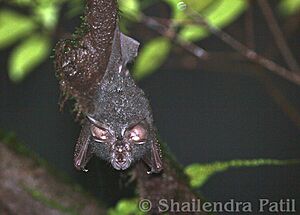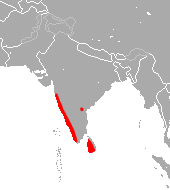Lesser woolly horseshoe bat facts for kids
Quick facts for kids Lesser woolly horseshoe bat |
|
|---|---|
 |
|
| Conservation status | |
| Scientific classification | |
| Genus: |
Rhinolophus
|
| Species: |
beddomei
|
 |
|
| Lesser woolly horseshoe bat range | |
The Lesser Woolly Horseshoe Bat is a small, furry bat. It's also known as Beddome's Horseshoe Bat. You can find these bats living in India and Sri Lanka. They like to live in warm, wet forests, dark caves, and even in cities!
Contents
About the Lesser Woolly Horseshoe Bat
How it Got its Name
This bat was first described as a new species in 1905. A scientist from Denmark named Knud Andersen gave it its scientific name.
The second part of its scientific name, beddomei, honors a British officer. His name was Colonel Richard Henry Beddome. He was a naturalist who spent a lot of time studying nature in India. Colonel Beddome was the person who found the very first bat of this species. He found it in the Wayanad district of India.
What it Looks Like
The Lesser Woolly Horseshoe Bat is about 7 centimetres (2.8 in) long from its head to its body. Its forearm, which is part of its wing, is about 6 centimetres (2.4 in) long. When its wings are spread out, they can reach about 33 centimetres (13 in) wide! Female bats are usually a bit bigger than males.
This bat has rough, woolly fur. Its body is a dark grayish-brown color. The top side of its body looks a bit grizzled, like it has tiny specks of different colors. Its wing membranes are blackish-brown. The bat also has big, pointy ears and a special nose-leaf. This nose-leaf has a unique and complex shape.
Bat Senses and Habits
How Bats "See" in the Dark
The Lesser Woolly Horseshoe Bat is a nocturnal animal. This means it is active at night. To find its way around in the dark, it uses something called echolocation.
Echolocation is like using sound to "see." The bat sends out high-pitched sounds. These sounds bounce off objects and come back to the bat. By listening to the echoes, the bat can figure out where things are. It can tell how far away they are and what shape they are. This helps it find food and avoid bumping into things.
The sounds this bat makes for echolocation are very high. They are between 31.0 and 38.3 kilohertz (kHz). The loudest parts of its calls are usually around 38.5 or 38.7 kHz. Each call lasts for about 48 to 58 seconds.
Related pages
- Rhinolophus sedulus, a species of bat found in Brunei, Indonesia, and Malaysia, commonly known as the lesser woolly horseshoe bat


